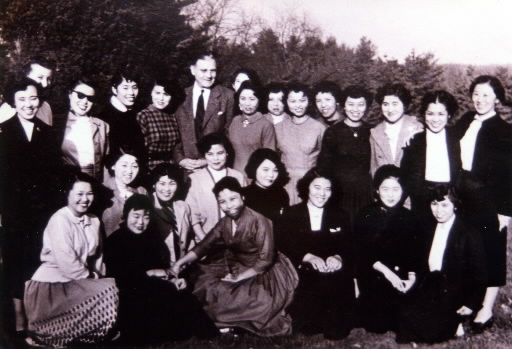Hiroshima Girls, Part 2: Bridging Japan and the United States [5]
Jul. 3, 2010
"Apostles of Peace" move government to provide more support for survivors
by Masami Nishimoto, Staff Writer
This feature series on the "Hiroshima Girls," also known as "Hiroshima Maidens," is a close look at a number of Japanese women who were impacted by the atomic bombing of Hiroshima. The series was originally published in 1996.
Norman Cousins, the driving force behind the medical treatment project, called the Japanese women "Apostles of Peace." During their time receiving treatment in the United States, from 1955 to 1956, The New York Times, one of the nation's major newspapers, covered the project in detail. [Norman Cousins died in 1990 at the age of 75.]
The arrival of the 25 women was reported with three photos. The newspaper also covered what the women did in the hospital on the anniversary of the bombing on August 6. In all, the newspaper carried 16 news stories on the "Hiroshima Girls," which reflects the keen interest they generated.
In one article, one of the women was quoted as saying, "The horror of the atomic bombing is similar to the attack on Pearl Harbor by Japan." This reassured and satisfied the public, who held the belief that the atomic bombings were necessary to end the war. On the other hand, another article stated: "We must not pat ourselves on the back for the treatment being given to these badly injured survivors." Such articles reveal conflicting thoughts over the use of the atomic bomb, a weapon of mass destruction.
A TV station in Hollywood broadcast a program depicting the life of Rev. Kiyoshi Tanimoto, who advocated the project. Two of the "Hiroshima Girls" appeared in the program in silhouette. In a clever twist, the program also brought in the co-pilot of the Enola Gay, the airplane which dropped the atomic bomb. As a result of this program, the TV station successfully raised 50,000 dollars (18 million yen at the time) in just one brief month from more than 20,000 American citizens.
Of the four Japanese doctors who accompanied the women to the United States, only one man is still alive. Dr. Tomin Harada, 84, who lives in Naka Ward, Hiroshima, recalled, "The donations by the American citizens reflected their understanding that the tragedy of the atomic bombing was not over. They saw squarely what nuclear weapons had wrought. And the girls' treatment in the United States provided a spark for the Japanese government to provide more support to the survivors."
This led to the enactment of the Atomic Bomb Medical Relief Law in 1957, a year after the women returned to Japan. In addition, making use of the money donated by U.S. citizens for the "Hiroshima Girls," Dr. Harada and other members of the Hiroshima Atomic Bomb Casualty Council began conducting plastic surgery on 18 female patients at the newly-opened Hiroshima Atomic Bomb Survivors Hospital.
After returning to Japan, each of the women pursued an individual path. Some got married, while others started working or entered university. Some became involved in the ban-the-bomb movement, which was widespread in Japan in those days. When a former host family member, who was a Quaker and an ex-military man, boarded a ship to stage a protest against nuclear testing, the women wrote to encourage the members of his family remaining at home.
But the women gradually stopped taking part in such high-profile activities, as if by agreement. They disbanded the Satsuki Club, their group which was named after the traditional Japanese name for the month of May, the month the women left Japan for the United States for treatment. One of the group's former leaders, now a 71-year-old resident of Minami Ward, Hiroshima, said, "Some of us have husbands and children, some even have grandchildren, while others are single. Each one of us has led a very different life from the others." Her manner clearly conveyed her wish that the women now be left alone.
Among the "Apostles of Peace" who conveyed the reality of the atomic bombing to the people of both Japan and the United States, five have died, 17 live in Hiroshima, and three live in North America. The youngest one has turned 58.
Hatsuko Yokoyama, who accompanied the "Hiroshima Girls" to the United States and looked after them as if she were their mother, still offers them advice. The 87-year-old resident of Nishi Ward, Hiroshima said, "All the girls have overcome the wounds of the bombing and have walked the world with dignity. They have met wonderful people. For this reason, I hope they will continue conveying their valuable experiences to many others who have no direct knowledge of the war."
At the Hiroshima Red Cross and Atomic Bomb Survivors Hospital, there are five wheelchairs which bear the name of Ida Day, who organized the host family program. [Ida Day died at the age of 86 in 1993.] The wheelchairs were donated in a bequest from Ms. Day. Acting as intermediaries between Ms. Day's executor and the hospital were former "Hiroshima Girls." Ms. Yokoyama uses one of the wheelchairs whenever she visits the hospital for check-ups since her health began to fail. Sitting in the wheelchair, she feels the love and warmth of the people she once knew.
(Originally published on July 12, 1996)








